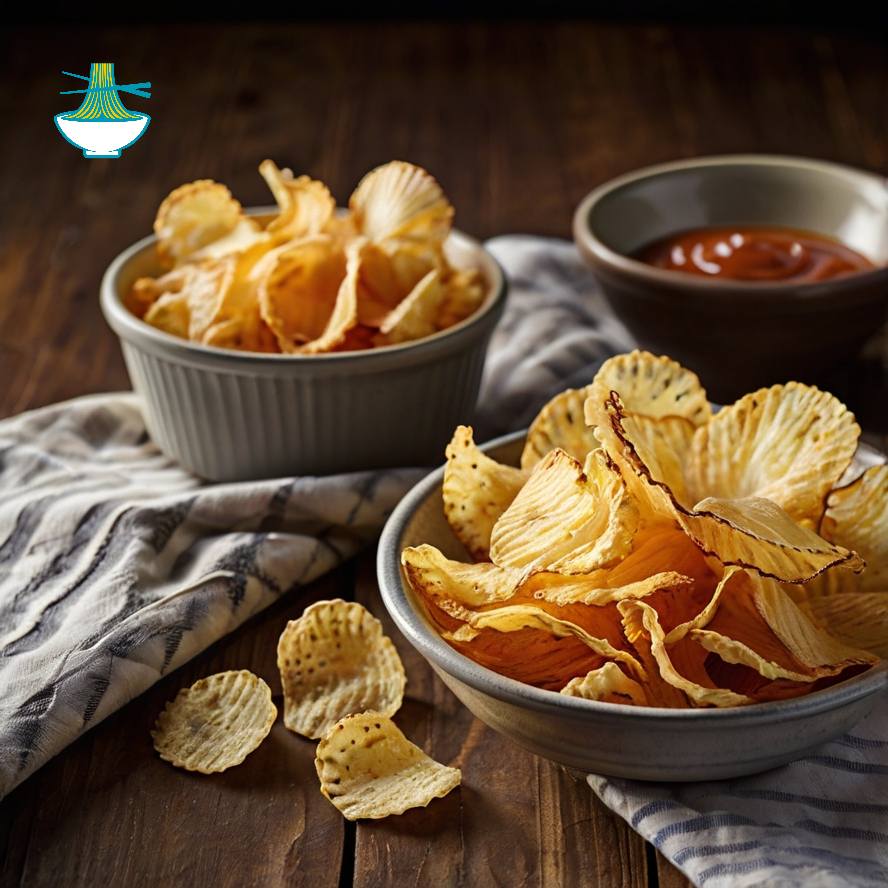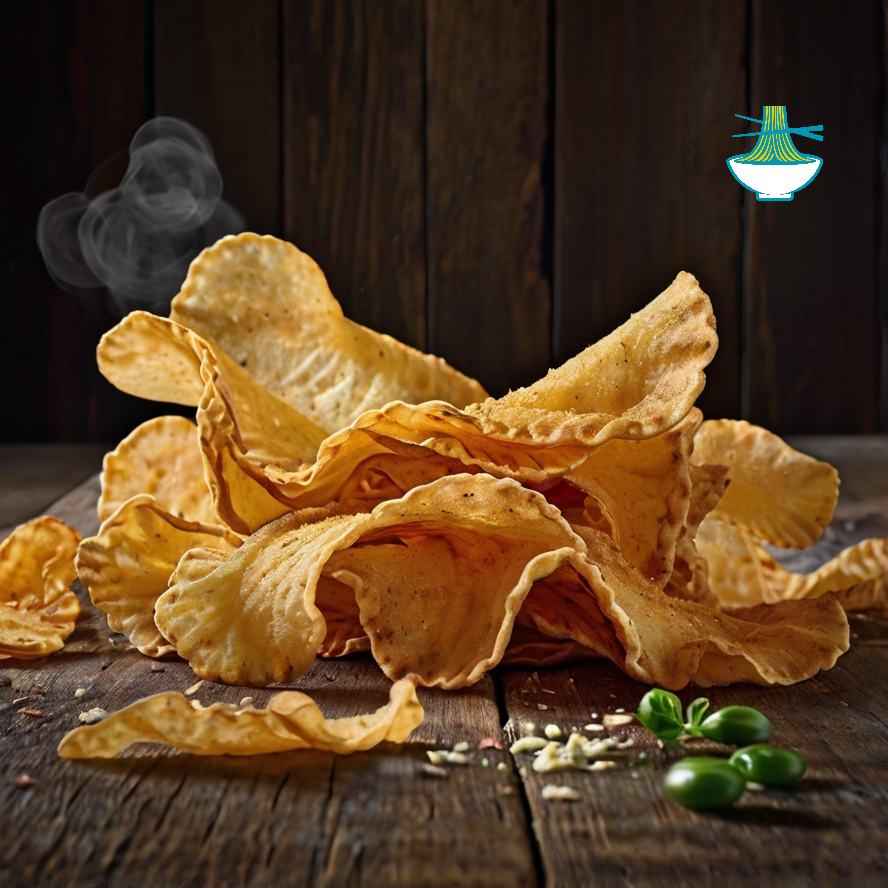Ruffles potato chips are famous for their distinct wavy texture and satisfying crunch. Not only do they stand out in terms of texture, but they are also ideal for holding up to dips, making them a go-to snack for many. While the chips are delicious on their own, they also offer some surprising nutritional benefits. Rich in vitamins and minerals, Ruffles can provide a source of energy when consumed in moderation. However, like most processed snacks, they are also high in sodium and fats, so it's important to enjoy them as part of a balanced diet. Whether you enjoy them at a party or as a quick snack, Ruffles are an undeniably popular choice worldwide.
Ingredients:
- 4 large russet potatoes
- 1 liter vegetable oil (for frying)
- Salt to taste
Instructions:
- Wash and Peel the Potatoes: Start by thoroughly washing 4 large russet potatoes to remove any dirt or debris. Peel the potatoes using a vegetable peeler to get rid of the skin. This will leave you with smooth potato flesh that’s perfect for crisping up.
- Slice the Potatoes: Using a sharp knife or mandoline slicer, carefully slice the potatoes into thin, even wavy slices. Aim for slices that are approximately 1/8-inch thick to ensure a consistent crunch. If you're using a mandoline, you can adjust the thickness to your liking. The key here is to make sure the slices are uniform for even frying.
- Heat the Oil: Pour 1 liter of vegetable oil into a deep pan or fryer, and heat it to 350°F (175°C). You can use a thermometer to monitor the oil's temperature to ensure it's hot enough for frying. If you don't have a thermometer, you can test the oil by dropping a small piece of potato into the oil—if it sizzles and floats to the surface, the oil is ready.
- Fry the Potato Slices: Carefully add the potato slices in small batches to the hot oil, making sure not to overcrowd the pan. Fry the slices for about 3-4 minutes or until they turn golden and crispy. Stir occasionally to ensure even cooking and prevent them from sticking together.
- Drain the Chips: Once the chips are golden brown and crispy, use a slotted spoon to remove them from the hot oil. Drain the excess oil by placing them on a plate lined with paper towels. This will help absorb any leftover oil and keep the chips crispy.
- Season and Serve: While the chips are still hot, season them with salt to taste. You can also experiment with other seasonings like garlic powder, paprika, or even a pinch of cayenne pepper for an extra kick. Serve the freshly made chips with your favorite dip, whether it’s a creamy ranch, salsa, or guacamole.
Enjoy your homemade Ruffles potato chips, knowing that you’ve created a delicious snack from scratch!
Healthy Alternatives for Lower Fat and Sodium Content:
If you're aiming to reduce the fat and sodium in your chips:
- Air frying instead of deep frying: Air fryers can cook chips with little to no oil, making them a healthier alternative. This significantly reduces the fat content while still providing a crispy texture.
- Baking the chips: You can bake the potato slices in the oven instead of frying them. Use a light spray of olive oil to help them crisp up without using excessive oil.
- Low-sodium seasoning: To lower the sodium content, consider using seasoning alternatives like lemon zest, vinegar, or nutritional yeast to enhance the flavor without relying on salt.
Tips for Healthier Chips:
While homemade Ruffles potato chips are delicious, you can make them even healthier with a few adjustments:
- Use healthy oils: Instead of vegetable oil, you can use healthier oils like olive oil or avocado oil. These oils contain healthier monounsaturated fats and are rich in antioxidants, which can improve heart health.
- Spice it up without salt: Instead of using excessive salt, you can add flavor with herbs and spices like garlic powder, paprika, oregano, or rosemary. This way, you can enjoy delicious chips with fewer unhealthy ingredients and lower sodium content.
Risks of Overconsumption:
While homemade chips are tasty and offer some nutrients, it's important not to overindulge. Eating too many chips can be detrimental to your health due to:
- High fat content: Even when using healthier oils, chips are still high in fat, and consuming them in large quantities can contribute to weight gain and cardiovascular problems.
- Excess sodium intake: Consuming too much sodium can lead to high blood pressure, kidney disease, and other health issues. Therefore, it's important to enjoy chips in moderation as part of a balanced diet.
Storing Chips for Freshness:
Proper storage can help maintain the crispiness and flavor of your homemade chips:
- Use an airtight container: After making your chips, let them cool completely and then store them in an airtight container. This helps prevent moisture from making the chips soggy.
- Paper bags for crispiness: You can store the chips in a paper bag instead of plastic to reduce moisture build-up. This will help keep them crispy for longer.
- Keep them in a cool, dry place: Avoid storing the chips in a humid environment, as moisture can cause them to lose their crunch. A pantry or cupboard away from sunlight is ideal.
Frequently Asked Questions:
Can potato chips be considered a healthy snack?
- Answer: "In moderation, potato chips can provide energy, but they should be part of a balanced diet due to their high sodium and fat content. Opt for healthier preparation methods like baking or air frying to make them a better snack option."
Can I use a different oil for frying the chips?
- Answer: "Yes, you can use olive oil or coconut oil as healthier alternatives to vegetable oil. These oils provide healthier fats and add a different flavor to the chips."
Can I reduce the sodium in the chips?
- Answer: "Yes, you can reduce the amount of salt used or replace it with lower-sodium alternatives such as herbs, spices, or even a dash of lemon juice. This will enhance the flavor without adding too much sodium."
What’s the best way to store homemade chips?
- Answer: "Store homemade chips in an airtight container in a cool, dry place to keep them fresh and crispy. For an even crisper texture, you can use a paper bag instead of a plastic one to avoid moisture."
Can I make homemade potato chips in a healthier way?
- Answer: "Yes, by baking the chips in the oven or using an air fryer with minimal oil, you can significantly reduce the fat content while still enjoying a crispy snack.

Nutritional values and benefits
1. Potatoes (4 large russet potatoes)
- Calories: 350
- Carbohydrates: 80g
- Protein: 7g
- Fat: 0g
- Sodium: 0mg
Vitamins:
- Vitamin C: 40mg (45% DV)
- Vitamin B6: 0.5mg (25% DV)
Nutritional Benefit: Potatoes are an excellent source of vitamin C, which boosts the immune system and promotes skin health. They also provide a good amount of vitamin B6, supporting brain function and metabolism.
2. Vegetable Oil (1 liter for frying)
- Calories: 8,000
- Carbohydrates: 0g
- Protein: 0g
- Fat: 900g
- Sodium: 0mg
Vitamins:
- Vitamin E: 20mg (120% DV)
Nutritional Benefit: Vegetable oil is rich in fat, specifically healthy unsaturated fats, and provides vitamin E, an antioxidant that helps protect cells from damage.
3. Salt (to taste)
- Calories: 0
- Carbohydrates: 0g
- Protein: 0g
- Fat: 0g
- Sodium: 500mg (depends on the amount used)
Nutritional Benefit: Salt enhances the flavor of chips and provides sodium, a mineral necessary for fluid balance and nerve function. However, it should be used in moderation to avoid excess sodium intake.
Potatoes' Nutritional Benefits Beyond Vitamins:
In addition to the vitamins and minerals provided by potatoes, they also offer other health benefits:
- Dietary fiber: Potatoes, especially when eaten with the skin, are an excellent source of dietary fiber. Fiber helps support digestion, regulate blood sugar levels, and maintain healthy cholesterol levels.
- Antioxidants: Potatoes contain antioxidants such as carotenoids and flavonoids that help protect the body from oxidative stress and may reduce the risk of chronic diseases.
Enjoy your homemade Ruffles while keeping in mind their delicious crunch and the nutritional benefits they offer!


Comments